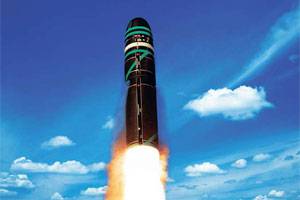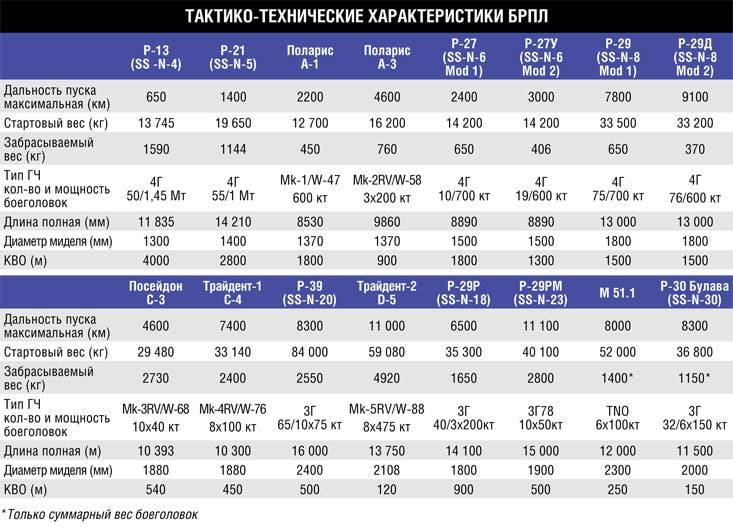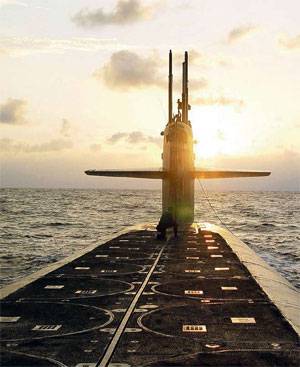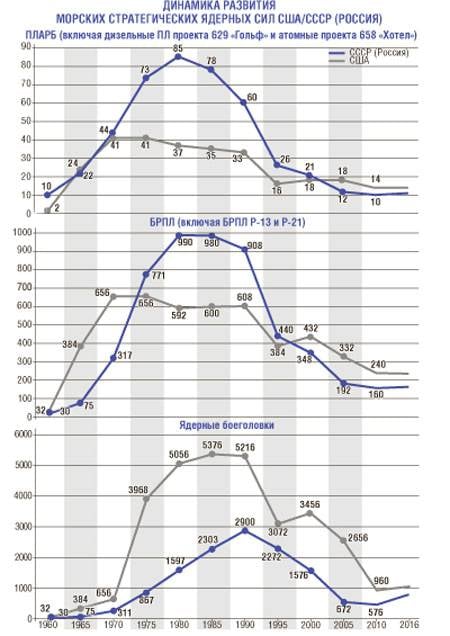Salt rocket race
For the sake of justice, it should be noted that the forefather of this weapon is Werner von Braun, who in the fall of 1944 proposed to place their V-2 missiles in floating containers towed by a submarine, which should have served as a launcher. But by the will of fate and the heroism of our soldiers, this project had to be carried out by Soviet and American rocket engineers in the fierce competition of the Cold War.
Underwater Cosmodrome
Initially, success favored the Americans. In the summer of 1956, the fleet initiated and generously sponsored the NOBSKA research project. The goal was to create promising models of missile and torpedo weapons for surface and submarine ships fleet. One of the programs involved the creation of a missile submarine based on existing diesel and nuclear. Four 80-ton liquid fuel (liquid oxygen + kerosene) Jupiter S BRDS under the project were placed in transport and launch containers in a horizontal position outside the solid hull of the boat. Before the start of the rocket had to be translated into a vertical position and refuel. Both U.S. nuclear weapons developers participated in the project on a competitive basis - LANL (Los Alamos National Laboratory) and freshly baked, non-practical LLNL (Lawrence Livermore National Laboratory), led by Edward Teller. The storage of liquid oxygen in separate tanks on the submarine and the need to transfer it from the onboard supply to the rocket tanks immediately before launch were initially considered a dead end, and the project was rejected at the sketch stage. In the fall of 1956, at a meeting in the Ministry of Defense with the presence of all the designers, Frank E. Boswell, the head of the marine ammunition testing station, raised the question of the possibility of developing solid-fuel ballistic missiles five to ten times lighter than Jupiter S, with a flight range from 1000 to 1500 miles Immediately, he asked the developers of nuclear weapons: “Can you create a compact device weighing 1000 pounds and 1 megaton in five years?” Representatives of Los Alamos immediately refused. Edward Teller writes in his memoirs: "I got up and said: we in Livermore can do it in five years, and it will give 1 megaton." When I returned to Livermore and told my guys about the work that they had to do, their hair stood on end. ”
The Lockheed company (now Lockheed Martin) and Aerojet undertook the work on the rocket. The program was named Polaris, and already on September 24 of 1958, the first (unsuccessful) test launch of the Polaris A-1X rocket from the ground-based PU took place. The following four were also emergency. And only 20 April 1959, the next start was successful. At this time, the fleet reworked one of its projects of the Scorpion Platform SSN-589 in the world's first George Washington SSBN (SSBN-598) with a surface displacement of 6019 tons, underwater - 6880 tons. To do this, a 40-meter section, in which 16 vertical launch shafts were placed, was embedded in the central part of the boat behind the fence of sliding devices (wheelhouse). The circular deviation of the rocket when shooting at a maximum range of 2200 kilometers was 1800 meters. The rocket was equipped with the Mk-1 monobloc head part detached in flight, equipped with a W-47 thermonuclear charger. In the end, Teller and his team managed to create a revolutionary fusion device for their time: the W47 was very compact (460 mm in diameter and 1200 mm in length) and weighed 330 kilograms (in the Y1 model) or 332 kilograms (Y2). Y1 had 600 kilotons of energy, Y2 was twice as powerful. These very high, even by modern criteria, indicators were achieved by a three-stage construction (division-synthesis-division). But W47 had serious reliability issues. In 1966, the 75 percent of the stockpiles of 300 warheads of the most powerful Y2 units were considered faulty and could not be used.
Hello from Miass
On our side of the iron curtain Soviet designers went the other way. In 1955, at the suggestion of S. P. Korolev, Viktor Petrovich Makeev was appointed chief designer of SKB-385. From 1977 he is the head of the enterprise and the general designer of the machine-building design bureau (now the SRC named after academician V.P. Makeev, Miass). Under his leadership, the machine-building design bureau became the leading scientific and design organization in the country that solved the problems of developing, manufacturing and testing sea-launched missile systems. For three decades, three generations of SLBMs have been created here: the P-21 is the first missile with an underwater launch, the P-27 is the first small-sized rocket with factory fueling, the P-29 is the first marine intercontinental, the P-29Р is the first marine intercontinental with a divided head .

SLBMs were built on the basis of the LRE on high-boiling fuel, which allows achieving a greater coefficient of energy-mass perfection in comparison with solid-fuel engines.
In June, the 1971 of the year was decided by the military-industrial complex under the USSR Council of Ministers on the development of solid-propellant SLBMs with intercontinental range. Contrary to the prevailing and well-established ideas in historiography, the assertion that the Typhoon system in the USSR was created as a response to the American Trident is incorrect. The actual chronology of events suggests otherwise. According to the decision of the military industrial complex, the D-19 "Typhoon" complex was created by the machine-building design bureau. The project was supervised directly by the general designer of the design bureau of machine-building V.P. Makeev. The chief designer of the D-19 complex and the P-39 rocket is A. P. Grebnev (USSR Lenin Prize winner), the leading designer is V. D. Kalabukhov (USSR State Prize laureate). It was supposed to create a rocket with three variants of the head parts: single-block, with MOLDVEH with 3 – 5 medium power blocks and with MERVHL with 8 – 10 low power blocks. The development of the conceptual design of the complex was completed in July of 1972. Considered several variants of missiles with different dimensions and with differences in the layout.
The resolution of the USSR Council of Ministers on 16 of September 1973 of the year was assigned to the development of OCR Variant - the D-19 complex with the 3М65 / Р-39 "Osetre" rocket. At the same time, the development of solid-fuel 3М65 rockets for SSBNs of the 941 project was launched. Earlier, on February 22, 1973 issued a resolution on the development in Yuzhnoye Design Bureau of a technical proposal for the RT-23 ICBM complex with the 15Ж44 rocket with the unification of the 15Ж44 and 3М65 first-stage engines. In December 1974, the development of the draft design of the 75 tons rocket was completed. In June, the 1975-nd was adopted to supplement the draft design, leaving only one type of warhead - 10 MWR IN with 100 kiloton capacity. The length of the starting glass increased from 15 to 16,5 meter, the launch weight of the rocket increased to 90 tons. By the August 1975 of the year, the USSR Council of Ministers decree fixed the final layout of the missile and combat equipment: a low-power 10 RGCH IN with a range of 10 thousands of kilometers. In December, 1976 and February 1981, additional regulations were issued, specifying fuel type changes from 1.1 class to 1.3 class on the second and third stages, which resulted in a decrease in the range of the missile to 8300 kilometers. Ballistic missiles use solid fuels of two classes - 1.1 and 1.3. The energy content of the 1.1 type fuel is higher than the 1.3. The first also has the best technological properties, high mechanical strength, resistance to cracking and the formation of grains. Thus, less susceptible to accidental ignition. At the same time, it is more prone to detonation and is close in sensitivity to conventional explosives. Since the safety requirements in the technical specifications for the ICBMs are much tougher than for the SLBMs, in the first they apply 1.3 class fuel, and in the second - 1.1 class. The reproaches of the Western and some of our experts in the technological backwardness of the USSR in the field of the technology of solid propellant solid propellants are absolutely not fair. The Soviet P-39 SLBM is one and a half times heavier than the D-5 precisely because it was manufactured using ICBM technology with excessive security requirements, completely unnecessary in this case.
Slippery weight
The third generation of nuclear missiles in submarines required the creation of special thermonuclear charges with improved weight and size characteristics. The most difficult was the creation of a small-sized warhead. For the designers of the All-Russia Research Institute of Instrument Engineering, this problem began with the announcement by the Deputy Minister of Medium Machine-Building on the Nuclear Weapons Complex A. D. Zakharenkov of 1974 in April about the characteristics of the Trident’s warhead - Mk-4RV / W-76. The American warhead was a sharp cone with a 1,3 meter height and a base diameter of 40 centimeters. The warhead's weight is about 91 kilograms. The location of the special-purpose weapons of the warhead was unusual: it was also located in front of the charge (in the toe of the unit - a radio sensor, protection and cocking stages, inertial), and behind the charge. It was necessary to create something similar in the USSR. Soon, the machine-building design bureau released a preliminary report confirming information about the American warhead. It indicated that a material based on carbon filaments was used for its hull, and an approximate estimate of the weight distribution between the hull, nuclear charge, and special automatics was given. In the American warhead, according to the authors of the report, the shell accounted for 0,25 – 0,3 warhead weight. For special automatics - no more than 0,09, everything else was a nuclear charge. Sometimes false information or deliberate misinformation on the part of the opponent stimulates the engineers of competing parties to create more advanced or even ingenious designs. This was exactly the case for almost 20 years - the overstated specifications served as role models for Soviet developers. In reality, it turned out that the American warhead weighs almost twice as much.

In the VNII instrument making with 1969 year, work was carried out on the creation of compact thermonuclear charges, but without reference to a specific ammunition. By May, 1974-th were tested several charges of two types. The results were disappointing: the warhead turned out to be 40 percent heavier than the foreign counterpart. It was necessary to select materials for the hull and to work out new devices for special automation. All-Russian Research Institute of Instrument Engineering attracted to the work of the Research Institute of Communications Minsredmash. An extremely light special automation was created in the Commonwealth, not exceeding 10 per cent of the warhead's weight. By 1975, the energy release was almost doubled. In the new missile systems it was supposed to install separable warheads with the number of warheads from seven to ten. In 1975, the All-Russia Research Institute of Experimental Physics KB-11 (Sarov) was involved in this work.
According to the results of work carried out in 70 – 90-s, including on ammunition of small and middle class power, an unprecedented qualitative growth of the main characteristics determining combat effectiveness was achieved. At times, the specific energy of nuclear weapons is increased. Products 2000-x - 100-kilogram 3-32 of small class and 200-kilogram 3-X37 middle-class power for missiles R-29Р, P-29RMU and P-30 developed to meet modern requirements for enhanced security at all stages of the life cycle, reliability, security. For the first time, an inertial adaptive blasting system is used in the automation system. In combination with the sensors and devices used, it provides increased safety and security in abnormal conditions during operation and unauthorized actions. A number of tasks are also being solved to increase the level of counteraction to the missile defense system. Modern Russian warheads are far superior to American designs in power density, security and other parameters.
Salt rocket race
The key positions that determine the quality of strategic missile weapons and recorded in the protocol to the SALT-2 Treaty are, naturally, the starting and throw weight.
Item 7 of the 2 article of the treaty: “The starting weight of an ICBM or SLBM is the own weight of a fully loaded missile at the time of launch. The weighted weight of an ICBM or SLBM is the total weight of: a) its warheads or warheads; (b) Any standalone unit for the breeding or other appropriate devices, for targeting a single warhead either for separating or for breeding and targeting two or more warheads; c) its means of overcoming defenses, including the design for their separation. The term “other relevant devices”, as used in determining the throwing weight of an ICBM or SLBM in the second agreed statement to the 7 clause of the 2 article of the contract, means any device for breeding and pointing two or more warheads or for targeting one warhead that can report additional warheads speed no more than 1000 meters per second. " This is the only documented and legally documented and fairly accurate definition of the throwing weight of a strategic BR. It is not entirely correct to compare it with the payload of the PH used in civilian industries for the construction of artificial satellites. There is a “dead weight”, and the missile weight of a combat missile includes its own propulsion system (DU), which can partially fulfill the function of the last stage. For ICBMs and SLBMs, an additional delta in 1000 speed meters per second gives a significant increase in range. For example, an increase in the speed of the warhead from 6550 to 7480 meters per second at the end of the active section leads to an increase in the launch range from 7000 to 12 000 kilometers. Theoretically, the dilution zone of warheads of any ICBM or SLBM equipped with a MIRV-IN (MIRV) can represent a trapezoidal area (inverted trapezium) 5000 kilometers in height and bases: from the starting point to 1000, to the upper 2000. But in fact, it is an order of magnitude smaller for most missiles and is strongly limited by the engine of the dilution unit and the fuel supply.
Only 31 July 1991, the real numbers of starting masses and payloads (throw weight) of the American and Soviet ICBMs and SLBMs were officially announced. The preparation of START-1 has come to an end. And only during the work on the treaty, the Americans were able to assess how accurate the data on Soviet missiles provided by the intelligence and analytical services in the 70 – 80s were. For the most part, this information turned out to be erroneous or in some cases inaccurate.
It turned out that the situation with the American figures in the environment of "absolute freedom of speech" is not better, as one might suppose, but much worse. Data in numerous Western military and other media in reality turned out to be far from the truth. The Soviet side, the experts who carried out the calculations, when preparing documents both under the SALT-2 Treaty and on START-1, relied precisely on the published materials on American missiles. Invalid parameters, which appeared as early as 70, migrated from independent sources to the pages of official tabloids of the US Department of Defense and archive files of manufacturers. The figures provided by the American side during the mutual data exchanges immediately after the conclusion of the contract and in the 2009 year do not give the real weight of American missiles, but only the total weight of their warheads. This applies to almost all ICBMs and SLBMs. The exception is the ICBM MX. Her weight drop in official documents is specified exactly, down to the kilogram - 3950. It is for this reason that, using the example of an ICBM MX, we will take a closer look at its design - what does the rocket consist of and what elements of the MS are included in the drop weight.
Rocket inside

The rocket has four stages. The first three solid fuel, the fourth is equipped with rocket engine. The maximum speed of the rocket at the end of the active section at the moment of shutdown (cutoff of thrust) of the engine of the 3-th stage is 7205 meters per second. Theoretically, at this moment, the first warhead can be separated (range - 9600 km), the 4 stage is launched. At the end of its operation, the warhead has a speed of 7550 meters per second, the last warhead is separated. Range - 12 800 kilometers. The additional speed reported by the 4 st stage is no more than 350 meters per second. According to the terms of the OCB-2 Agreement, the rocket is formally considered a three-stage one. Remote control RS-34 seems to be not a stage, but an element of the design of the warhead.
The throw-in weight includes the Mk-21 warhead rearing unit, its platform, the RS-34 LRE, and the fuel supply — in total 1300 kilograms. Plus 10 warheads Mk-21RV / W-87 265 kilograms. Instead of a part of the warheads, complexes of means for overcoming missile defense can be loaded. The drop weight does not include passive elements: the head fairing (about 350 kg), the transitional compartment between the MS and the last stage, as well as some parts of the control system that are not involved in the operation of the breeding unit. Total it turns out 3950 kilograms. The total weight of all ten warheads is 67 percent of the drop weight. In the Soviet SS-18 MBR (P-36М2) and SS-19 (УР-100 Н), this indicator is respectively 51,5 and 74,7 percent. There were no questions on the ICBM MX then, there is no now - no doubt, the rocket belongs to the light class.
In all official documents published over the past 20 years, the 1500 kilograms (in some sources 1350) for Trident-1 and 2800 kilograms for Trident-2 are indicated as the weighted weight of American SLBMs. This is only the total weight of the warheads - eight Mk-4RV / W-76 165 kilograms, or the same Mk-5RV / W-88 330 kilograms each.
The Americans deliberately took advantage of the situation, maintaining up to now distorted or even false ideas of the Russian side about the capabilities of their strategic forces.
"Tridents" - offenders

14 September 1971, the US Secretary of Defense approved the decision of the Navy Coordination Council to begin R & D on the ULMS program (ballistic missile of extended-range submarines). The development of two projects was envisaged: “Trident-1” and “Trident-2”. Formally, Lockheed received an order for the Trident-2 D-5 from the fleet in 1983, but in fact the work was started simultaneously with the Trident-1 C-4 (UGM-96A) in December 1971. The Trident 1 and Trident 2 SLBMs belonged to different classes of missiles, respectively C (caliber 75 inches) and D (85 inches), and intended to arm two types of SSBNs. The first is for the existing Lafayette submarines, the second is for the promising Ohio at the time. Contrary to popular belief, both missiles belong to the same SLBM generation. The Trident-2 is made using the same technologies as the Trident-1. However, due to the increased size (diameter - by 15%, length - by 30%), the starting weight doubled. As a result, we managed to increase the launch range from 4000 to 6000 nautical miles, and the throwing weight - from 5000 to 10 000 pounds. The Trident-2 rocket is a three-stage, solid propellant. The head part with the diameter two midsize smaller than the first two stages (2057 mm instead of 2108) includes the Hercules X-853 engine occupying the central part of the compartment and made in the form of a cylindrical monoblock (3480х860 mm), and a warhead platform located around it. The breeding unit does not have its own remote control, its function is performed by the third-stage engine. Due to these rocket design features, the length of the Trident 2 warhead can reach 6400 kilometers. The third stage equipped with fuel and the platform of the breeding unit without warheads weighs 2200 kilograms. For the Trident-2 rocket, there are four options for booting the warhead.
The first one is “heavy warhead”: 8 Mk-5RV / W-88, drop weight - 4920 kilograms, maximum range - 7880 kilometers.
The second is “lightweight warp”: 8 Mk-4RV / W-76, drop weight - 3520 kilograms, maximum range - 11 100 kilometers.
Modern boot options according to the limitations of START-1 / 3:
the first is 4 Mk-5RV / W-88, weight is 3560 kilograms;
the second is 4 Mk-4RV / W-76, weight is 2860 kilograms.
Today we can say with confidence that the rocket was created between the SALT-2 (1979) and START-1 (1991) Treaties, in violation of the first: “Each party undertakes not to create, not to test and not deploy SLBMs that have more weight to be dropped than the largest, according to the drop weight, lightweight ICBMs ”(Art. 9, paragraph“ e ”). The largest of the lighter ICBMs was SS-19 (UR-100НТТХ), whose throwing weight was 4350 kilograms. A solid reserve for this parameter of the Trident-2 missiles provides Americans with ample opportunities for “return potential” if there is a sufficiently large stock of warheads.
"Ohio" - on the needles
The US Navy today has in its composition 14 SSBN type "Ohio". Some of them are based in the Pacific on the Bangor Navy (17-I squadron) - eight SSBNs. The other is in the Atlantic at the Kings Bay naval base (20-I squadron), six SSBNs.
The main provisions of the development policy of the US nuclear strategic forces for the near future are fixed in the Nuclear Posture Review Report 2010 announced by the Pentagon. In accordance with these plans, it is planned for the second half of 2020-x to begin a gradual reduction in the number of deployed missile carriers from 14 to 12.
It will be carried out “in a natural way”, after the expiration of the service life. The withdrawal of the first Ohri-class SSBNs from the Navy is scheduled for 2027 year. To replace the boats of this type should come bomber new generation, passing at the moment under the abbreviation SSBN (X). A total of 12 new construction boats are planned.
R & D is in full swing, it is expected to begin replacing existing missile carriers at the end of the 2020s. The new submarine will be a standard displacement on the 2000 tons of heavier "Ohio" and will be equipped with 16 PU SLBM instead of 24. The estimated cost of the entire program is 98 – 103 billion dollars (of which research and development will cost 10 – 15 billion). On average, one submarine will cost 8,2 – 8,6 a billion dollars. The commissioning of the first SSBN (X) is scheduled for 2031 year. With each subsequent it is planned to withdraw from the Navy one SSBN type "Ohio". The launch of the latest boat of the new type is scheduled for 2040 year. During the first decade of service life, these SSBNs will be armed with a Trident-2 SLBM with an extended D5LE life cycle.
Information